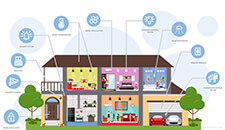Smart Home
A smart home is a house or other dwelling with automated or remotely controlled components. Some "smart" components require a proprietary interface though most smart home features can be controlled by a mobile device or computer.
While there are no technical requirements for a smart home, a basic smart home might have remote controlled lighting and an automated thermostat. If your home has a smart lighting system, for example, you can configure different lights to turn on during the day and automatically switch off all the lights late at night. A smart thermostat can be configured to keep the house warm during the day and cool at night. If you leave your house for several days, you can set the thermostat to "vacation mode," which will reduce the energy usage of your HVAC system.
Advanced smart homes may include several other "smart" components. For example, smart blinds can shut to keep the house cool or open to allow more heat in through the windows. Some blinds can be programmed to open slowly in the morning to help you wake up to natural lighting. A smart security system can monitor suspicious activity and sound an alarm or contact the police if necessary. It may also provide convenient features such as automatically unlocking the front door and turning on lights when you pull into the driveway.
A smart home may also include "smart appliances" that you can monitor and control remotely. For example, you can check if you remembered to run the dishwasher before you left the house and turn it on from your mobile app if you forgot. If you have a smart oven, you can turn it on while you are on the road so that your food will be cooked when you get home. A smart refrigerator can detect the items it contains and let you know when you need to get more milk when you're at the grocery store, for example.
Several different manufacturers make smart components and appliances. While it is ideal to design a smart home from the ground up using a single brand of components, in many cases that isn't possible. Therefore, when adding smart components to your home, you may have to get accustomed to multiple interfaces. Fortunately, most smart components come with easy-to-use apps that run on both iOS and Android devices.
 Test Your Knowledge
Test Your Knowledge